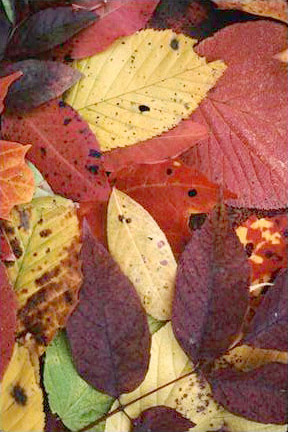
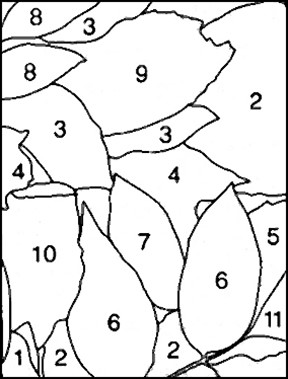
Species in this Photograph
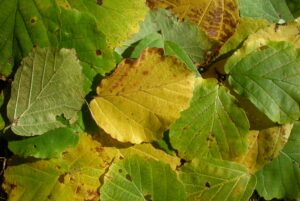
Hamamelidaceae family
A tall shrub growing in the understory of forests, occasionally near the forest edges. The alternate leaves have uneven bases. It flowers during the autumn as the leaves turn yellow and fall.
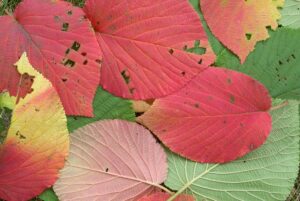
Caprifoliaceae family
This is a rather low-growing shrub often seen in forest understory as well along edges in cool moist woods. Its large roundish opposite leaves turn a beautiful wine-red throughout October.
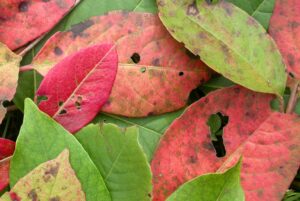
Caprifoliaceae family
This is a shrub of medium height with opposite leaves that turn bright red throughout October. It is common in the understory and at the edge of the forest.
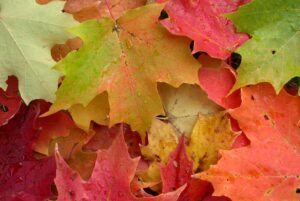
Aceraceae family
A large and common tree of our roadsides and cool forests on fertile sites. Its opposite leaves with wavy edges and characteristic maple shape turn varying luminous shades of yellow to orange and red from middle to late October.
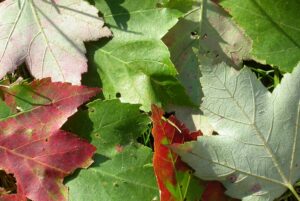
Aceraceae family
This is one of the most common and showy trees in these forests. Its opposite maple-shaped leaves with toothed edges turn varying shades of yellow to dark red from September into October. It commonly grows in the forest understory, on forest margins, in swamps and on the edges of wetlands where it provides an early swath of bright color during autumn.
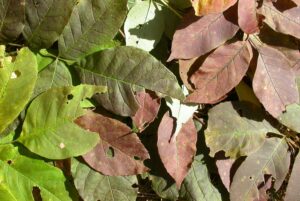
Oleaceae family
This is a large and handsome tree of our forests, often found near streams. Its opposite compound leaves turn from yellow to purple-brown in early to mid-October.
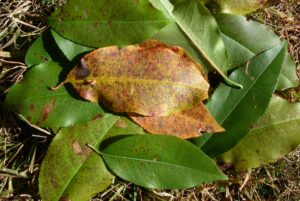
Rosaceae family
This tree can become quite large, but is more commonly found as a young sapling in disturbed areas and the forest understory. Its alternate finely toothed medium-sized leaves have a hairy mid-rib on the underside. They turn yellow to pink in mid to late October.
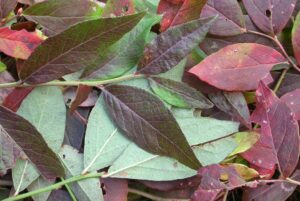
Ericaceae family
This is a common medium-tall shrub of the forest understory and edges, especially in moist sites. Its small alternate smooth-edged and oval leaves turn a dark red from mid-October into early November. It is also common along pond edges.
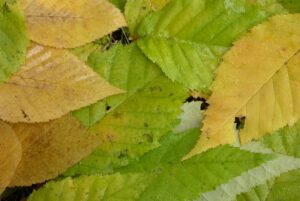
Betulaceae family
A fairly common medium-sized tree often associated with hemlock in moist sites and swamp edges, with silver gray to yellow curly bark. Its alternate finely toothed leaves turn yellow in mid-October.
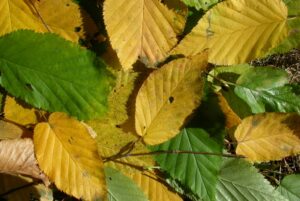
Fagaceae family
This large and handsome tree is very shade-tolerant and grows up in the understory of forests, with flat planes of branches and smooth gray bark. Its alternate coarsely toothed leaves turn yellow in mid-October and many are retained especially on smaller trees, even after they turn brown.
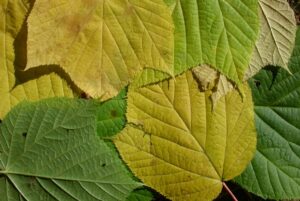
Aceraceae family
A small shade-tolerant tree often found in the understory of cool forests, with distinctive long white stripes on its green bark. Its large opposite and shallowly-lobed toothed leaves turn yellow in mid-October.
Conifers provide the green backdrop during the autumn color changes in New England forests. These are principally white pine and hemlock, although other pines may be introduced in plantations. Larches are the only conifers in these forests which lose their needles completely during the fall. These trees produce an autumn show of bright yellow in the swampy areas where they grow. The European larch may be introduced in plantations or in landscaping, to provide more autumn yellow color.
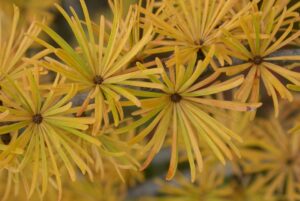
Pinaceae family
This medium-sized coniferous tree is intolerant of shade, and is mostly found in swamps and other wet areas. It is unusual because, although it is a conifer, it is not an evergreen. Its short needles are produced in whorls, and all of them turn yellow in the late autumn and fall from the tree. A very similar introduced species, the European larch, is often planted in yards and parks.
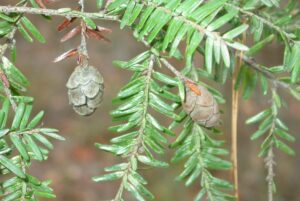
Pinaceae family
This large evergreen tree has short single flat needles and is very tolerant of shade. It is common around swamps, in gullies and on north-facing slopes. It drops a small percentage of its needles in the autumn.
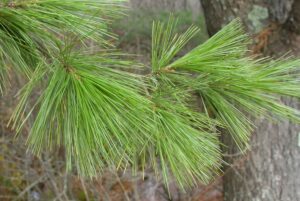
Pinaceae family
This large evergreen tree is very common in forests throughout this region. It has five needles in each cluster. Each autumn, one-third to one-half of its needles turn yellow-brown and drop.
All of these shrubs and trees produce varying amounts of anthocyanins during senescence. Sometimes these pigments are produced uniformly in the leaves, but often distinct patterns.
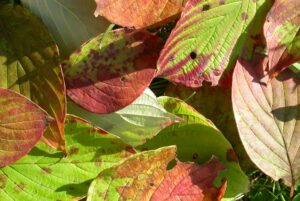
Cornaceae family
This is a small tree or large shrub often growing along roadsides and forest margins, but also in the understory. Unique among dogwoods, its leaves are alternate in position. The foliage begins to redden in early September, one of the earlier species to change color.

Rosaceae family
This tree can become quite large, but is more commonly found as a young sapling in disturbed areas and the forest understory. Its alternate finely toothed medium-sized leaves have a hairy mid-rib on the underside. They turn yellow to pink in mid to late October.
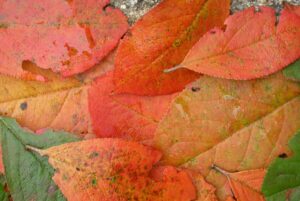
Rosaceae family
This low-medium sized shrub grows in the forest understory. Its alternate medium-sized spoon-shaped leaves turn orange to reddish in mid- to late October.

Ericaceae family
This is a common medium-tall shrub of the forest understory and edges, especially in moist sites. Its small alternate smooth-edged and oval leaves turn a dark red from mid-October into early November. It is also common along pond edges.

Caprifoliaceae family
This is a rather low-growing shrub often seen in forest understory as well along edges in cool moist woods. Its large roundish opposite leaves turn a beautiful wine-red throughout October.

Caprifoliaceae family
This is a shrub of medium height with opposite leaves that turn bright red throughout October. It is common in the understory and at the edge of the forest.

Aceraceae family
This is one of the most common and showy trees in these forests. Its opposite maple-shaped leaves with toothed edges turn varying shades of yellow to dark red from September into October. It commonly grows in the forest understory, on forest margins, in swamps and on the edges of wetlands where it provides an early swath of bright color during autumn.
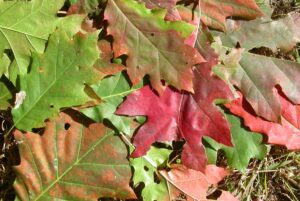
Fagaceae family
This large tree is very common in these forests. Its alternate sharply-pointed oak-shaped leaves turn red and then brown from late October to early November. Small trees often retain brown leaves through the winter.
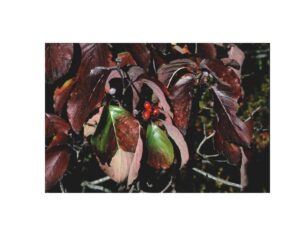
Cornaceae family
This small tree is found in damp forest edges, more commonly near the coast. Its opposite smooth-edged leaves turn a dark wine-red color in late October.
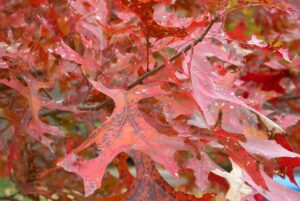
Fagaceae family
This medium-sized oak is found in drier upland sites in our forests. Its alternate oak-shaped leaves are more deeply divided than those of the red or white oaks. Brilliant red colors appear towards the end of October.
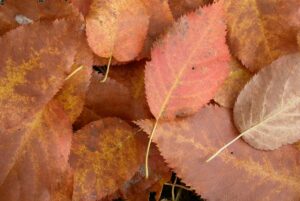
Rosaceae family
A small tree or tall shrub of the understory and forest edges. Its alternate finely toothed oblong leaves turn yellow brown to dull red in mid-late October.
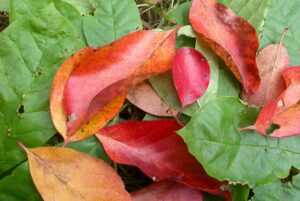
Nyssaceae family
A narrow-crowned tree with right-angle branches that is restricted to swamps and adjacent areas in our region. Its leaves are small, oval and alternate, and the handsome foliage turns orange to wine-red in early to mid-October.

Aceraceae family
A large and common tree of our roadsides and cool forests on fertile sites. Its opposite leaves with wavy edges and characteristic maple shape turn varying luminous shades of yellow to orange and red from middle to late October.

Anacardiaceae family
This tall shrub or small tree forms clumps from root suckers in fields, forest openings and along roadsides. Its alternate feather-compound leaves turn brilliant red throughout the autumn months.

Oleaceae family
This is a large and handsome tree of our forests, often found near streams. Its opposite compound leaves turn from yellow to purple-brown in early to mid-October.
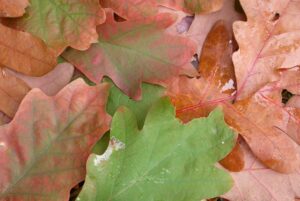
Fagaceae family
This is a large and rather common tree in these forests. Its alternate leaves have distinctively round lobes unlike the pointed lobes of red and scarlet oaks. The foliage turns a dull to brick-red in the second half of October.
All of these species turn yellow during the autumn, due to the breakdown of chlorophyll and the retention of some carotenoid pigments in their plastids. In a few cases, small amounts of anthocyanins may be produced, sometimes only in a few individuals in a population.

Fagaceae family
This large and handsome tree is very shade-tolerant and grows up in the understory of forests, with flat planes of branches and smooth gray bark. Its alternate coarsely toothed leaves turn yellow in mid-October and many are retained especially on smaller trees, even after they turn brown.
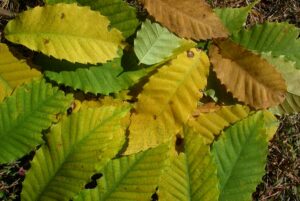
Fagaceae family
Once a large and dominant tree of these forests, this tree was laid low by an imported disease a century ago. It is now common as sprouts, whose large alternate sharply toothed leaves turn yellow in early October.
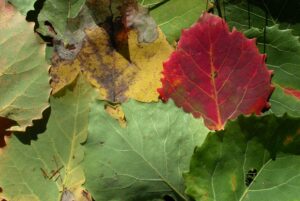
Salicaceae family
A medium-sized tree that is common in disturbed areas and roadsides. Its alternate coarsely toothed leaves turn yellow (and occasionally reddish) in mid-October.
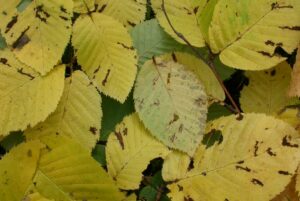
Betulaceae family
A small tree, often with many thin stems with chalky-white bark, and with alternate finely toothed triangular long-pointed leaves. Because it does not grow in any shade it is found in recently disturbed sites and along forest edges and roadsides. Its leaves turn yellow in mid-October.
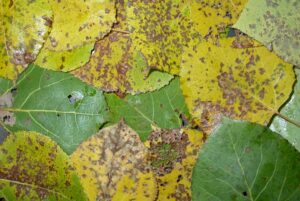
Salicaceae family
This small to medium-sized tree, which is intolerant of shade, spreads as root suckers, frequently forming dense stands on forest margins and road edges. Its alternate finely toothed roundish leaves move in gentle winds, inspiring its common name. The leaves turn yellow in mid-October.

Aceraceae family
A small shade-tolerant tree often found in the understory of cool forests, with distinctive long white stripes on its green bark. Its large opposite and shallowly-lobed toothed leaves turn yellow in mid-October.
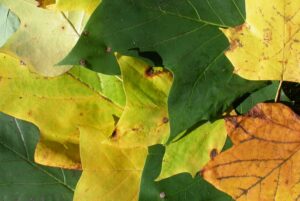
Magnoliaceae family
Large tree more common in forests to the south, but encountered at the Harvard Forest as a landscape tree, and it may be planted in surrounding communities. Its large tulip-shaped leaves turn yellow-brown in mid-October.
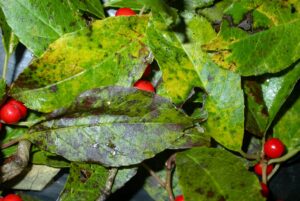
Aquifoliaceae family
A medium-sized shrub commonly growing in wet sites whose alternate bluntly-toothed leaves turn yellow with green spots (occasionally reddish too) in late October. Its red berries remain conspicuously on the plant into the winter.

Hamamelidaceae family
A tall shrub growing in the understory of forests, occasionally near the forest edges. The alternate leaves have uneven bases. It flowers during the autumn as the leaves turn yellow and fall.

Betulaceae family
A fairly common medium-sized tree often associated with hemlock in moist sites and swamp edges, with silver gray to yellow curly bark. Its alternate finely toothed leaves turn yellow in mid-October.